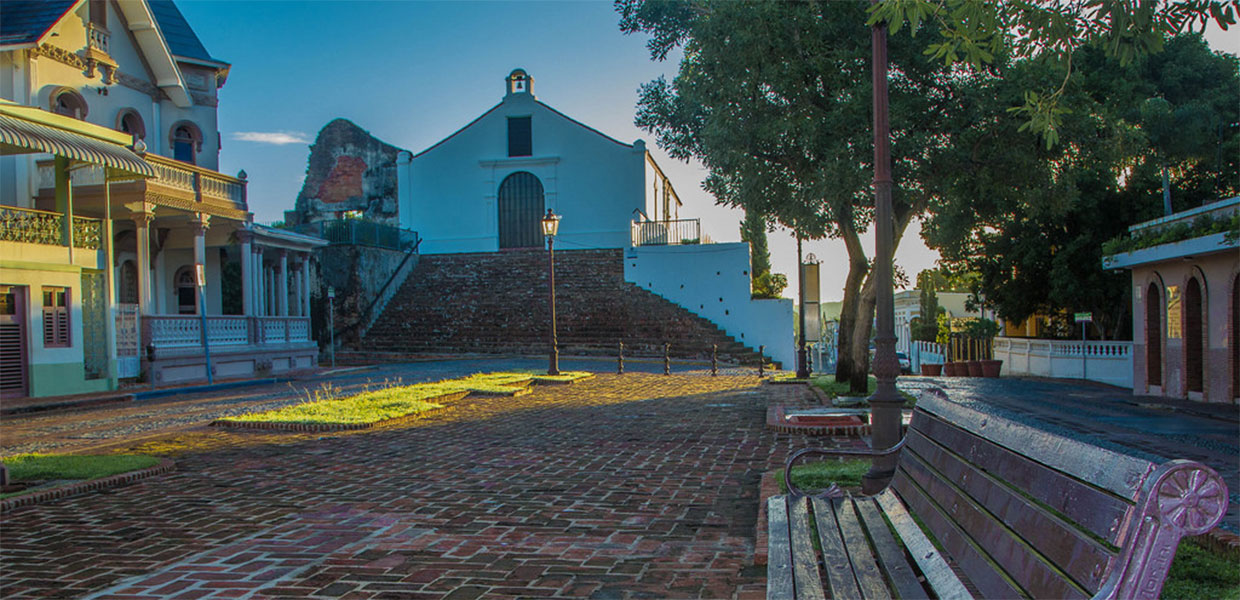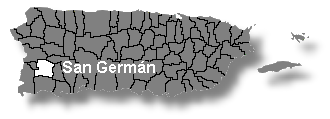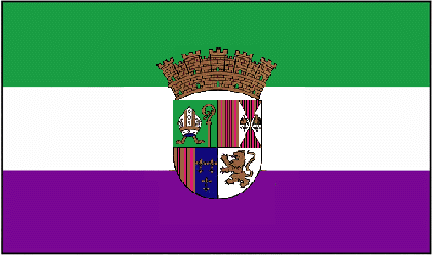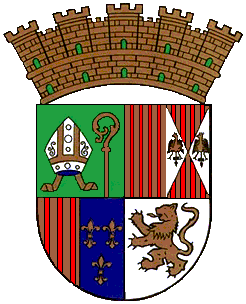
San Germán, Puerto Rico
The City of Hills

San Germán (sahn her-MAHN) is known as the “City of the Hills”, the “City of the Swallows”, the “Founding City”, the “Cradle of Puerto Rican Basketball” and the “Pilgrim City.” The patron saint is San Germán de Auxerre and residents are called sangermeños.
San Germán is bordered on the north by the municipalities of Mayagüez and Maricao, on the east by the municipality of Sabana Grande, on the west by Hormigueros and Cabo Rojo and on the south by the municipality of Lajas.
Geographically, it is part of the region called the western plains or coastal valleys. Its land is alluvial and very fertile. To the northeast, between San Germán and Maricao, is the ridge of the central mountain range.
San Germán is home to important architectural works of historic value. These include the Porta Coeli church, which dates to 1607 and contains a collection of colonial Mexican paintings; San Germán de Auxerre church, built in 1688; and several old residences located in the center of the city.
In the past, the municipality’s economy was based on agriculture and sugar cane was one of the most important crops. Today, some fruit orchards and livestock farms exist, but the economy is mainly based on manufacturing. Factories producing electrical and electronic appliances, electronic machinery, pharmaceutical products, textiles and food products, among other goods, are based in San Germán.
Foundation:
San Germán, was founded May 12, 1570 in the Hills of Santa Marta, although the transfer wasn’t completed until 1573. Rodrigo Ortíz Vélez is credited with its founding. Don Diego Colón named the town to honor Germana de Foix, a Navarrese-French princess who was King Fernando the Catholic’s second wife.
Numerous Taínos native tribes existed in all of San Germán’s territory. According to historian Aurelio Tió Nazario the native governors were: Chief Mabo el Grande in Higüey; Chief Agüeybana in Tavora; Chief Aymaco in Villa Sotomayor; Chief Guaryma in Guadianilla; and Chief Huamay or Chief Guamá in the Hills of Santa Marta.
On June 15, 1877 King Alfonso XII granted San Germán the title of city.
Towards the first half of the XIX century this municipality contained the following wards: Ancones, Arenal, Benavento, Caín Alto, Caín Bajo, Duey, Guamá, Guanajibo, Guánica, Hormigueros, Indiera, Lajas Arriba, Lavadero y Jagüitas, Llanos, Tuna y Cotuy, Minillas, Montoso, Palmarejo, Retiro, Río Prieto, Sabana Eneas, Sabana Grande, Sabana Yeguas, San Germán Pueblo, Santuario de Lajas and Santuario del Rosario.
During the rest of the century numerous changes in the composition of this municipality took place. Guánica was annexed to Yauco, and with many of San Germán’s wards, municipalities like Hormigueros, Maricao and Lajas were created. The last change took place in 1940, when the Cotuy ward changed to Cotuí.
In 1856 a cholera epidemic to which many succumbed in Puerto Rico was felt in San Germán in dramatic way: it produced 2,843 casualties and it was necessary to improvise cemeteries in all the wards to bury to the “coléricos,” as the infected people were called.
On August 10, 1898, General Schuann in charge of the United States forces took possession of the city, thus concluding the colonial presence of Spain in Puerto Rico.
Location:
 Located in the southwestern region of the island, it is contiguous with Mayagüez and Maricao to the north, with Lajas to the south, Hormigueros and Cabo Rojo to the west, and with Sabana Grande to the east.
Located in the southwestern region of the island, it is contiguous with Mayagüez and Maricao to the north, with Lajas to the south, Hormigueros and Cabo Rojo to the west, and with Sabana Grande to the east.
Area:
140.4 sq km / 54.0 sq mi
Population:
37,105 (census 2000)
Population Density:
264.2 per sq km / 687.1 per sq mi
People are known as:
Sangermeños
San Germán is also known as:
Ciudad de las Lomas (The City of Hills)
Ciudad de las Golondrinas (The City of Swallows)
Ciudad Fundadora de Pueblos (Founding City of Towns)
Ciudad Cuna del Baloncesto Puertorriqueño (The Home of Basketball)
Ciudad Peregrina (Pilgrim City)
Wards: San Germán, Puerto Rico

| Census 2000: Population by Wards – San Germán |
Habitantes |
| Ancones | 1,742 |
| Caín Alto | 3,064 |
| Caín Bajo | 1,130 |
| Cotuí | 751 |
| Duey Alto | 1,471 |
| Duey Bajo | 951 |
| Guamá | 2,099 |
| Hoconuco Alto | 742 |
| Hoconuco Bajo | 1,681 |
| Maresúa | 1,231 |
| Minillas | 3,484 |
| Retiro | 7,361 |
| Rosario Alto | 761 |
| Rosario Bajo | 1,675 |
| Rosario Peñón | 725 |
| Sabana Eneas | 2,188 |
| Sabana Grande Abajo | 2,603 |
| San Germán Town | 3,307 |
| Tuna | 139 |
| Total | 37,105 |
Source: Censo 2000
Patron:
San Germán de Auxerre
San Germán de Auxerre Parish
Apartado 305
San Germán, P.R. 00683
(787) 892-1027

Topography:
It belongs to the Western Coastal Plain region. Towards the northeast we find the Central Mountain Range where the hills begin with the Tetas de Cerro Gordo (883 meters) and the Alto del Descanso (768 meters).
Hydrography:
It is watered by the Guanajibo, Cupeyes, Caín, Hoconuco and Nuevo Pasos rivers.
Economy:
Manufacturing includes: electrical items, electronic machinery, pharmaceutical, textile and nutritional products. Sugar cane and fruits are cultivated, and dairy farms are present in small scale.
Average Salary:
$293.00 weekly (1998)
Flag:

- Green – the episcopal dignity and the colors of the Shield of Chistopher Columbus and his son, Virrey of America.
- White – The purity of the blood of the great families who colonized San Germán, according to book of Fray Iñigo Abad. The families of San Germán were distinguished; and the purity of the Guanajibo River, since their waters were considered medicinal, were taken to Europe for such purpose.
- Violet – Color of the Shield of Juan Ponce de Leon, first governor of Puerto Rico.
Coat Of Arms:
 The pontificial hat and the walking stick represents San Germán, bishop of Auxerre (France) and patron of the city. The pontificial hat represents excellence, the sign of the episcopal dignity: it represents the fullness of the priesthood. The walking stick represents the power of the bishops to shepherd their spiritual flock. The green background represents the pontificial hat of patriarchs, archbishops and bishops, as well as their cords and tassels that for some years have been established also by the Holy See as the standard color of the canopies and other episcopal parameters. But the green color, along with the gold, which are the colors of this first quarter, have in addition another symbolism: First they remember don Diego Colón, first-born of the discoverer of America, and that in his character of governor of the Indies, with seat in Santo Domingo, by decree named the population San Germán. It was his intention to honor Queen Germana de Folix, second wife of don Fernando the Catholic, the monarch who imposed and presided over the colonization of Puerto Rico.
The pontificial hat and the walking stick represents San Germán, bishop of Auxerre (France) and patron of the city. The pontificial hat represents excellence, the sign of the episcopal dignity: it represents the fullness of the priesthood. The walking stick represents the power of the bishops to shepherd their spiritual flock. The green background represents the pontificial hat of patriarchs, archbishops and bishops, as well as their cords and tassels that for some years have been established also by the Holy See as the standard color of the canopies and other episcopal parameters. But the green color, along with the gold, which are the colors of this first quarter, have in addition another symbolism: First they remember don Diego Colón, first-born of the discoverer of America, and that in his character of governor of the Indies, with seat in Santo Domingo, by decree named the population San Germán. It was his intention to honor Queen Germana de Folix, second wife of don Fernando the Catholic, the monarch who imposed and presided over the colonization of Puerto Rico.
- First Quarter: Granted to Christopher Columbus by the catholic kings, in gratefulness of the family shield of the Colonos, it has, in a green field a royal gold castle, which is a heraldry modification of the arms of the kingdom of Castile, which in turn has, a red field with a gold castle of three towers, the one in the middle being the tallest, lined in black and clarified in red. The green and gold remember, who gave San Germán its name.
- Second Quarter: The second quarter exhibits the arms of the kingdoms of Aragon and Sicily, where don Fernando the Catholic reigned.
- Third Quarter: In this quarter the arms combine with the County of Foix and the Kingdom of France, which constitute the family shields of Germana de Foix whose name perpetuates the city of San Germán.
- Fourth Quarter: Is Ponce de Leon’s shield, branch of Puerto Rico that corresponds to a lineage (of many ramifications) that connected with the royal house of Leon, adopting its arms with a rampant purple lion, crowned and armed in gold in a silver field. This same shield, alone and in combination with other heraldry quarter elements, are used in the houses of the Ponce de Leon of Spain. The branch of Puerto Rico, for some unknown reason, was designed without a crown, like in the old church of Santo Tomás (today San José) in San Juan, and in the seals that Monsignor Murga reproduced in his book about Ponce de Leon. In its shield, San German’s quarter perpetuates the memory of the conqueror of Puerto Rico, who always offered his stimulus and protection.
- The Crown: Is a civic or municipal standard and is used as a stamp for towns and cities, San Germán was assigned five towers to denote that this population formally obtained the title of city from the Spanish crown, in the last century.
Places To Visit:
- Bolas Bridge
- Morales House
- Ceiba Liberty Tree
- Historic Gallery
- Lola Rodríguez de Tió House
- Ramírez de Arellano y Rossell Museum
- Santo Domingo Plaza
- Three Races Mural
- Porta Coeli Church
- City Hall
- San Germán de Auxerre Church
- Main Plaza
- Kings Plaza
- San Sebastián Chapel
- San Germán Park
- Monument to Santa Rosa de Lima
- Bahr House
- Sol Theater
- Alfredo Ramírez Research Center Museum
- Former Train Station
Events:
- San Germán Auxerre Patron Saint Festival – July
- Anón Festival – September
- Christmas Festival – December
Distinguished Citizens:
- Juan Ponce de León Troche – Chronicler and grandson of the conquistador Juan Ponce de León.
- Francisco Mariano Quiñones – Abolitionist leader, politician, historian and writer. He represented Puerto Rico before the Information Board in Madrid, where he advocated for the abolition of slavery. He wrote novels, essays and the Historia de los partidos Reformista y Conservador de Puerto Rico.
- Ursula Cardona de Quiñones – Poet.
- Lola Rodríguez de Tió – Poet and patriot who wrote the patriotic verses for La Borinqueña during the era of the Grito de Lares. She defended her separatist ideas and was forced into exile with her husband, Bonocio.
- Manuel F. Rossy – Lawyer, journalist, orator and pro-statehood leader. He was a founding member and president of the Puerto Rican Republican Party and was president of the House of Delegates and House of Representatives.
- Aurelio Tió – Historian. Among his works is the Fundación de San Germán y su significación en el desarrollo político, económico, social y cultural de Puerto Rico. He was president of the Puerto Rican Academy of History.
- Coloma Pardo de Casablanca – Essayist and poet.
- Santiago Palmer Díaz – Senator and delegate to the Commonwealth Constituent Convention.
- Samuel R. Quiñones – One of the founders of the Popular Democratic Party and also a member of the Liberal Party.
- Sila Nazario de Ferrer – Senator.
Public Schools sorted by educational levels.
San Germán District
| Name | Level | Telephone | Address |
| AMINA TIÓ DE MALARET | Elementary | (787) 892-5750 | PO Box 80 |
| ANTONIA MARTÍNEZ | Elementary | (787) 264-3600 | PO Box 5000476 |
| BARTOLOMÉ DE LAS CASAS | Elementary | (787) 892-5756 | PO Box 5000257 |
| CARMEN BORRAS BATISTINI | Elementary | (787) 805-0006 | PO Box 735 |
| GEORGINA ALVARADO | Elementary | (787) 892-7590 | PO Box 65 |
| HENRY W. LONGFELLOW | Elementary | (787) 892-1358 | PO Box 65 |
| HERMINIA C. RAMÍREZ | Elementary | (787) 892-7105 | PO Box 65 |
| MARIANO ABRIL | Elementary | (787) 892-7403 | PO Box 5000257 |
| JULIO VÍCTOR GUZMÁN | Intermediate | (787) 892-1168 | PO Box 65 |
| LAURA MERCADO | Secondary | (787) 832-4155 | Correo General |
| LUIS MUÑOZ RIVERA | Secondary | (787) 892-7590 | PO Box 65 |
| FEDERICO DEGETAU | Secondary | (787) 892-7110 | PO Box 1095 |
| FRANCISCO MARIANO QUIÑÓNEZ | Secondary | (787) 892-6315 | PO Box 65 |
| GALO ROSADO | Secondary | (787) 892-0715 | PO Box 65 |
| LOLA RODRÍGUEZ DE TIÓ | High School | (787) 892-1320 | PO Box 206 |
Hymn:
By Raquel Quiñones
San Germán es mi pueblo querido,
en sus lomas alegres nació,
y no encuentro otro sitio en el mundo donde yo pueda ser tan feliz.
Es antiguo, legendario y muy culto,
y fue cuna de hombres grandes ayer,
de poetas, maestros artistas,
y de damas muy nobles también.
Porta Coeli se levanta orgulloso
cual reliquia de un tiempo que fue,
en sus muros antiguos aun vibra,
un pasado de gloria y de fe.
Yo no cambio mis verdes colinas
por París, Nueva York, ni Berlín
porque allí no se ven golondrinas
como siempre las vemos aquí.
Dios bendiga este pueblo tan más,
este pueblo en donde nació,
del que puedo yo estar orgulloso,
donde siempre me siento feliz.

